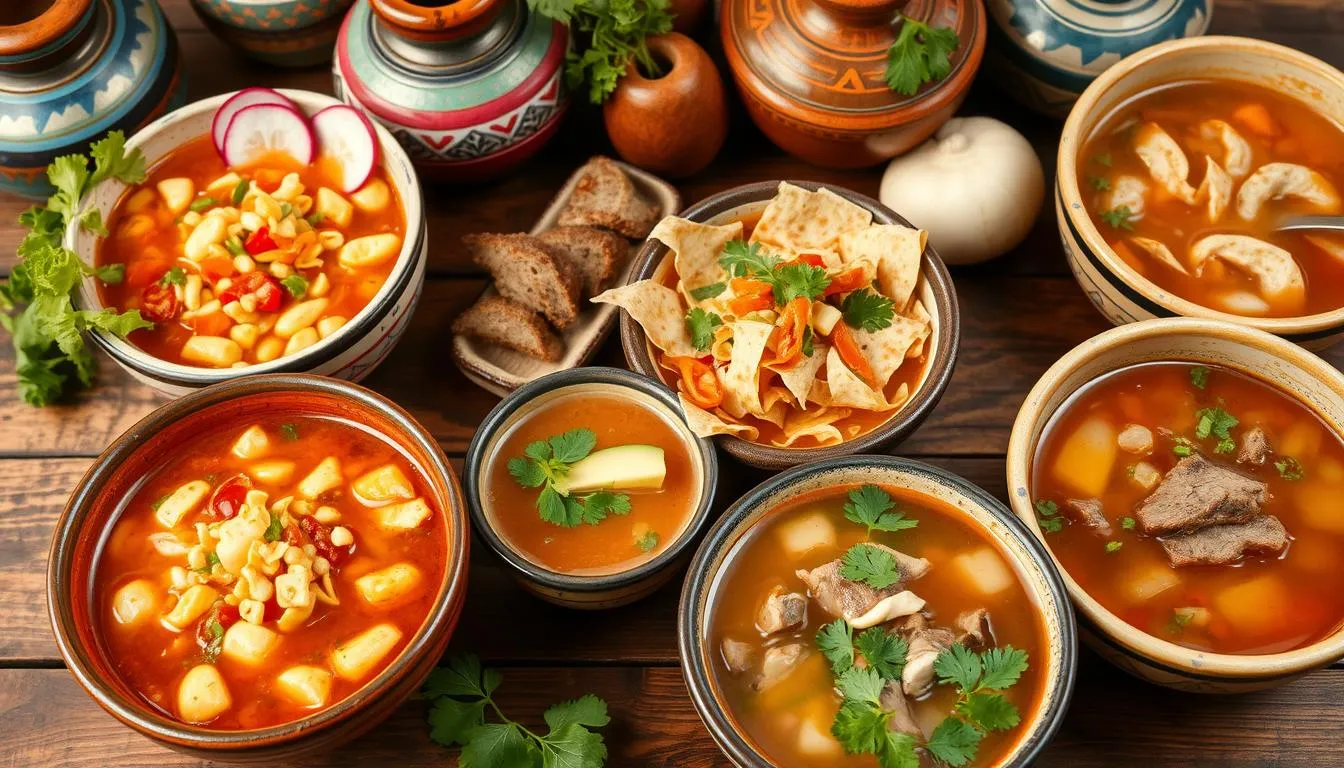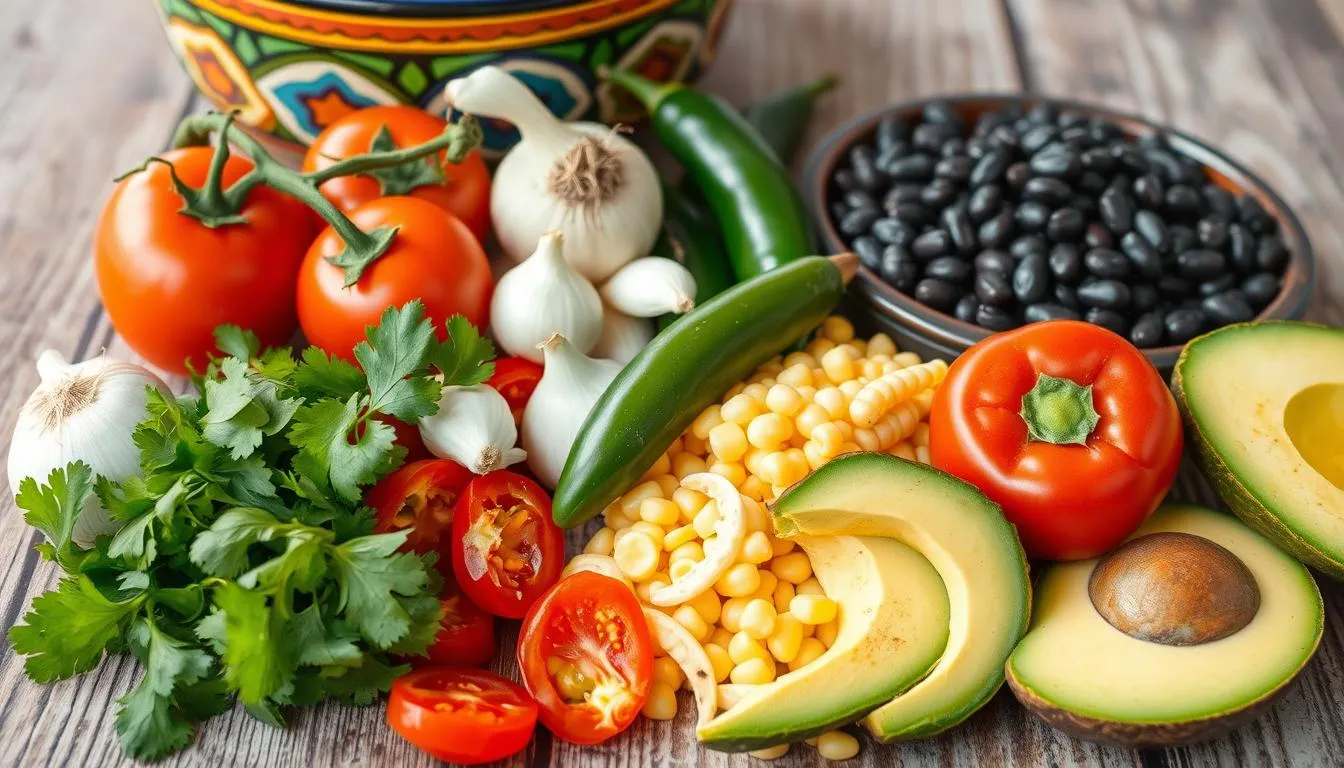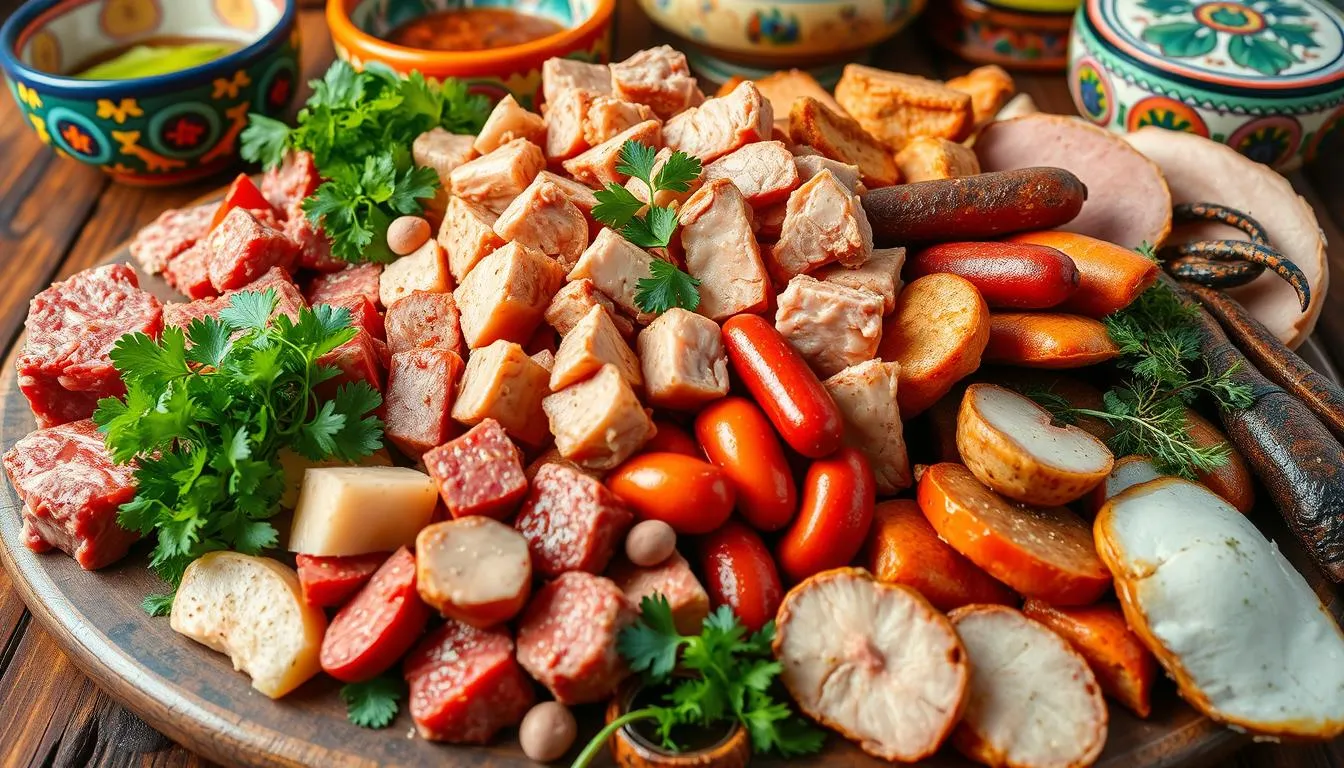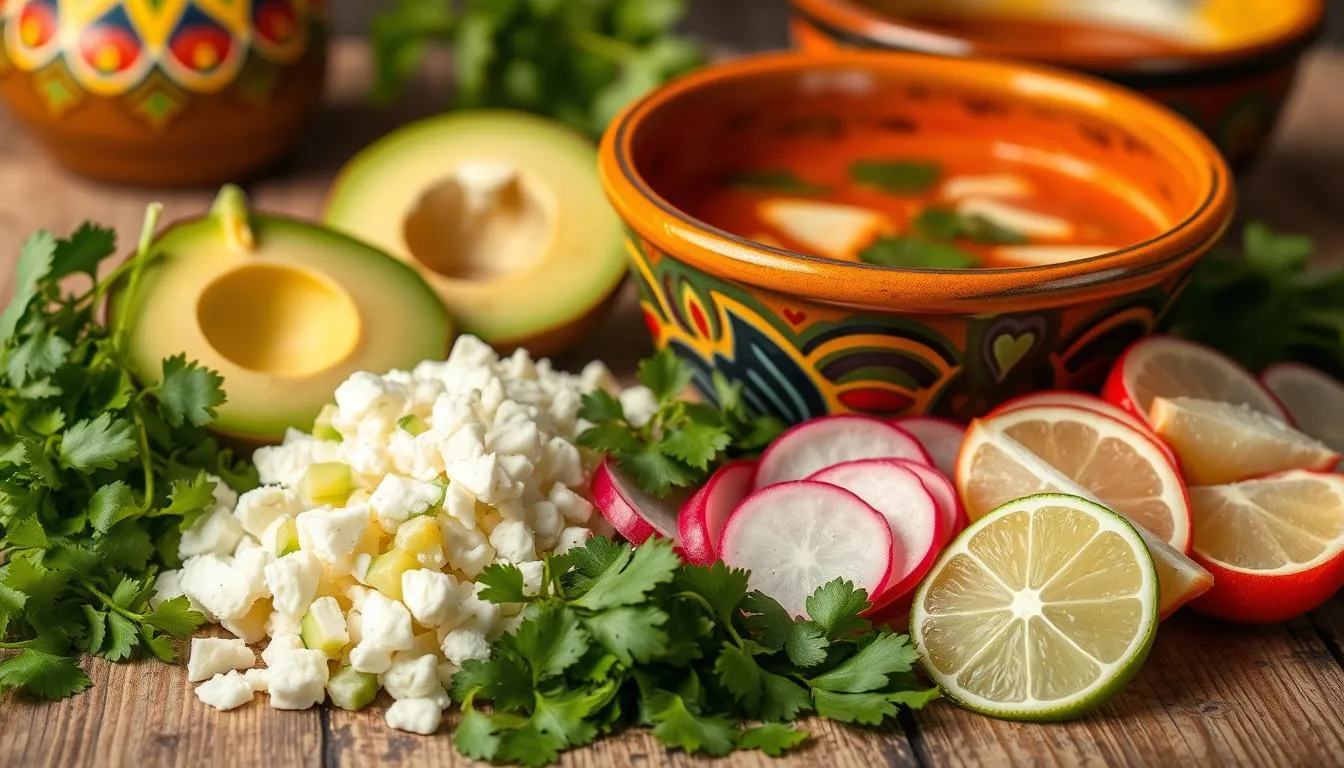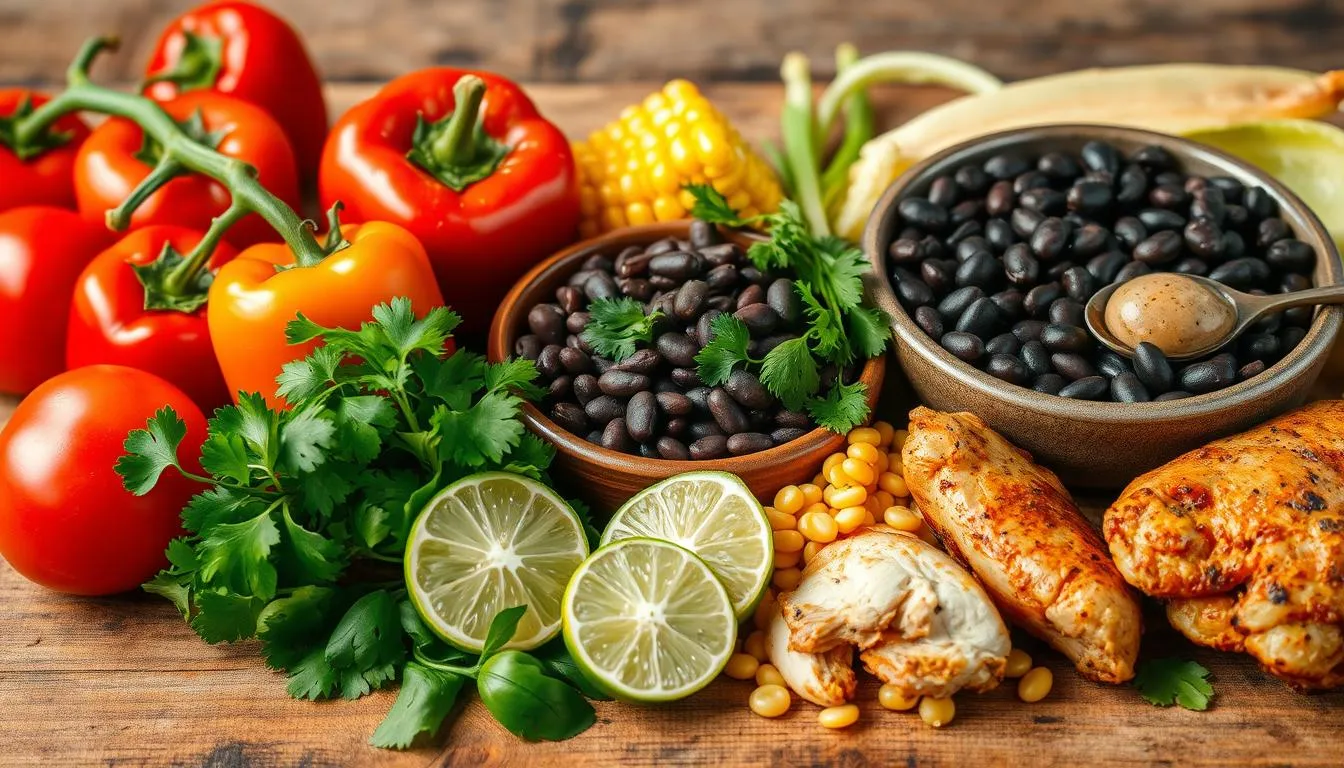What is Mexican soup made of? Mexican soups are a vibrant part of the country’s culinary tradition. They show off a wide range of ingredients that make simple things taste amazing. These soups mix old techniques with Spanish touches, creating dishes that people all over the world love.
Every part of Mexico adds its own special touch to soups. This shows off the local food and cooking ways. You can find everything from thick pozole to light tortilla soup, showing off the skill of Mexican cooks.
The ingredients in Mexican soups are more than just food. They tell stories of family, local pride, and a long history of cooking. These stories inspire both chefs and home cooks to keep making these delicious soups.
Key Takeaways
- Mexican soups represent complex culinary traditions
- Ingredients vary widely across different Mexican regions
- Traditional recipes blend indigenous and Spanish cooking techniques
- Soups are more than food—they’re cultural expressions
- Each soup tells a unique regional story
Discovering the Rich Heritage of Mexican Soups
Mexican soup history goes back thousands of years. It shows a deep connection to indigenous cultures. These dishes started with pre-Hispanic civilizations, long before Europeans arrived.
Regional Mexican soups are complex, showing Mexico’s varied landscapes and cultures. Each area has its own soup, using local ingredients and passed-down cooking skills.
Pre-Hispanic Origins of Soup Making
Ancient Mesoamericans like the Aztecs and Maya created the base of Mexican cooking. They used:
- Slow-cooking in clay pots
- Grinding with stone metates
- Native ingredients like corn, beans, and chiles
Regional Variations Across Mexico
Every region in Mexico has its own soup style. Each area has its own taste and ingredients.
| Region | Signature Soup | Key Ingredients |
|---|---|---|
| Yucatán | Sopa de Lima | Chicken, lime, tortilla strips |
| Jalisco | Pozole | Hominy, pork, dried chiles |
| Veracruz | Caldo Tlalpeño | Chicken, vegetables, chipotles |
Cultural Significance in Mexican Cuisine
“Soup is more than food in Mexico—it’s a story of history, family, and tradition.”
Mexican soups are more than just food. They carry cultural memory, linking families through shared meals and recipes. From small village kitchens to big city restaurants, these soups are key to Mexican food culture.
What is Mexican Soup Made of?
Mexican soup ingredients are at the heart of vibrant, flavorful dishes. These soups mix indigenous and Spanish influences. They offer a rich taste experience that’s more than just food.
Authentic Mexican soup recipes use a mix of ingredients for taste and texture. They often start with:
- Fresh vegetables like tomatoes, onions, and chiles
- Protein sources such as chicken, beef, or beans
- Native herbs including cilantro and epazote
- Aromatic spices that add depth and warmth
Mexican soups are complex because of their ingredients. These reflect the region’s cooking traditions. Each area of Mexico has its own special mix of ingredients and cooking ways.
| Ingredient Category | Common Examples | Flavor Profile |
|---|---|---|
| Chiles | Ancho, Guajillo, Pasilla | Smoky, Spicy, Complex |
| Proteins | Shredded Chicken, Beef, Pork | Rich, Hearty |
| Vegetables | Corn, Squash, Tomatoes | Fresh, Vibrant |
Each ingredient is key to Mexican soups’ unique taste. They turn simple parts into amazing dishes.
“Mexican soups are not just food, they are a celebration of culture and tradition on a plate.” – Mexican Culinary Expert
Essential Base Ingredients in Traditional Mexican Soups
Mexican cuisine is known for its rich flavors, thanks to the Mexican soup base. This base is key to making soups complex and delicious. It turns simple ingredients into amazing dishes.
Authentic Mexican soups get their unique taste from special ingredients. These ingredients create a strong and tasty base.
Stock and Broth Foundations
Traditional Mexican soup stocks are made with:
- Chicken bones for a rich, hearty base
- Beef bones for deeper, more intense flavors
- Vegetable trimmings for vegetarian options
Common Aromatics and Seasonings
The secret to a great Mexican soup is its aromatic ingredients:
- White onions
- Garlic
- Fresh cilantro
- Mexican oregano
Traditional Thickening Agents
Mexican cooks use different methods to get the right soup consistency:
| Thickening Agent | Traditional Use |
|---|---|
| Masa harina | Corn-based thickener for hearty soups |
| Pureed vegetables | Natural thickening method |
| Ground nuts | Adds richness and texture |
“The soul of Mexican cooking lies in its ability to transform simple ingredients into extraordinary flavors” – Mexican Culinary Experts
Each region of Mexico adds its own special touch to soups. This makes the Mexican soup base an art form that celebrates culinary diversity.
Popular Mexican Soup Varieties and Their Components
Mexican cuisine is known for its wide range of soups. These soups show the country’s rich food traditions. From the coast to the heart of Mexico, each soup is a cultural treasure.
- Pozole: A soup from before the Spanish arrived, made with hominy corn and meat. It’s topped with radishes, cabbage, and lime.
- Tortilla Soup: A spicy tomato soup with crispy tortilla strips, avocado, and cheese on top.
- Menudo: A strong tripe soup loved for its deep flavors. It’s often made on weekends.
Each soup has its own special touch, showing off local tastes and cooking ways. This variety shows how important soup is in Mexican food culture.
| Soup Name | Key Ingredients | Regional Origin |
|---|---|---|
| Pozole | Hominy, Pork, Chiles | Jalisco, Central Mexico |
| Tortilla Soup | Tomatoes, Tortillas, Chicken | Mexico City, Urban Centers |
| Menudo | Tripe, Red Chiles, Oregano | Northern Mexico |
“Soup in Mexico is not just food, it’s a connection to our ancestors and our land.” – Chef Ricardo Muñoz Zurita
The wide variety of Mexican soups shows the country’s amazing food diversity. It turns simple ingredients into unforgettable meals.
Fresh Vegetables and Herbs Used in Mexican Soups
Mexican soups are full of vibrant flavors. They get their taste from fresh Mexican soup vegetables and herbs. These ingredients turn simple broths into amazing dishes that show Mexico’s rich farming history.
The variety of vegetables and herbs in Mexican soups shows Mexico’s amazing biodiversity. Each region, from mountains to coasts, adds its own special produce. This makes each soup recipe unique.
Native Mexican Produce
Mexican soup vegetables are key to authentic flavors. Some common ones include:
- Chayote squash
- Calabaza (pumpkin)
- Nopales (cactus paddles)
- Jicama
- Poblano peppers
Seasonal Ingredient Selections
Seasonal choices are big in Mexican soup making. Chefs and home cooks pick vegetables at their freshest. This ensures the best taste and nutrition.
Herb Combinations for Authentic Flavors
Mexican herbs add deep, complex tastes to soups. Some classic mixes are:
- Epazote – earthy and pungent
- Cilantro – bright and fresh
- Mexican oregano – robust and slightly citrusy
- Hierba santa – anise-like flavor
“In Mexican cuisine, herbs are not just seasonings—they’re storytellers of culinary tradition.” – Traditional Mexican Chef
These chosen vegetables and herbs make simple soups into unforgettable dishes. They connect today’s kitchens with Mexico’s long food history.
Meat and Protein Options in Mexican Soups
Mexican soup meat is key to making tasty and healthy dishes. Proteins are the heart of traditional Mexican soups, adding rich flavors and nutrition. Each region in Mexico has its own way of adding protein to soups.
Traditional Mexican soups use a wide variety of proteins. This shows the country’s rich culinary heritage:
- Chicken (Pollo): A lean and versatile protein
- Beef (Res): Rich and hearty meat option
- Pork (Cerdo): Flavorful and tender protein
- Seafood: Popular in coastal regions
Each protein adds something special to Mexican soups. Chicken is light, while beef is more intense. Seafood like shrimp or fish adds a delicate touch to soups.
| Protein Type | Typical Soup | Flavor Profile |
|---|---|---|
| Chicken | Caldo de Pollo | Light, Comforting |
| Beef | Caldo de Res | Rich, Robust |
| Pork | Pozole | Hearty, Spicy |
“In Mexican cuisine, soup is more than food—it’s a celebration of protein and tradition.” – Chef Ricardo Muñoz
Vegetarian protein options are also becoming more popular. Legumes like beans and lentils add nutrition and depth to soups. This way, everyone can enjoy these delicious dishes.
The Role of Chiles and Spices
Chiles and spices are the heart of Mexican soup. They turn simple ingredients into lively dishes. Mexican soup chiles add depth and a unique flavor to recipes passed down through generations.
Fresh vs. Dried Chile Varieties
The variety of Mexican soup chiles is vast. Cooks use both fresh and dried chiles for different tastes:
- Fresh chiles like jalapeños and poblanos offer a sharp, fresh heat
- Dried chiles, such as ancho and guajillo, have richer, more intense flavors
- Smoky chipotles add a special layer to soups
Spice Blends and Combinations
Spices in Mexican soup are chosen with care. They create balanced flavors. Traditional mixes often include:
- Cumin for a rich, earthy taste
- Oregano for its herbal notes
- Coriander for a hint of citrus
Heat Levels and Flavor Profiles
Knowing the heat of chiles is key in making Mexican soup. The Scoville scale helps chefs find the right balance:
- Mild chiles: Poblano (1,000-1,500 Scoville units)
- Medium heat: Jalapeño (2,500-8,000 Scoville units)
- Hot chiles: Habanero (100,000-350,000 Scoville units)
“In Mexican cuisine, chiles are not just about heat—they’re about flavor, tradition, and soul.” – Rick Bayless
Garnishes and Toppings for Mexican Soups
Mexican soup garnishes turn simple dishes into amazing meals. These colorful toppings not only make the soup look good but also add flavor and texture.
Classic Mexican soup toppings make every bowl special. They turn a basic soup into a dish fit for a restaurant.
- Fresh lime wedges for bright acidity
- Crispy tortilla strips for crunch
- Diced avocado for creamy richness
- Crumbled queso fresco for salty bite
- Chopped cilantro for fresh herbal notes
Professional chefs know garnishes are key. They’re not just for looks; they balance flavors and add texture.
| Garnish | Flavor Profile | Texture |
|---|---|---|
| Lime Wedges | Tangy, Acidic | Liquid |
| Tortilla Strips | Neutral, Salty | Crunchy |
| Avocado | Creamy, Buttery | Smooth |
| Queso Fresco | Salty, Mild | Crumbly |
“A great soup is a canvas, and garnishes are the brushstrokes that complete the masterpiece.” – Mexican Culinary Tradition
Each topping has its own role in a balanced dish. Try different combinations to find your favorite soup.
Common Accompaniments and Side Dishes
Mexican soup sides make a meal more than just food. They turn a simple dish into a colorful journey. These sides add texture and nutrients, making the meal better.
Choosing the right sides for Mexican soup is an art. They’re picked to boost the flavor and make the meal complete. This way, they satisfy both hunger and curiosity.
Traditional Bread Pairings
Bread is key in Mexican soup sides. Here are some favorites:
- Bolillos: Crispy outside, soft inside
- Corn tortillas: Fresh and warm
- Teleras: Soft rolls great for dipping
Complementary Condiments
Condiments are essential for Mexican soup sides. They add depth and let you customize your meal.
| Condiment | Flavor Profile | Best Paired With |
|---|---|---|
| Lime wedges | Tangy and bright | Pozole, Menudo |
| Chopped cilantro | Fresh and herbal | Tortilla soup |
| Diced onions | Sharp and crisp | Most traditional soups |
“A great Mexican soup is not just about the broth, but the symphony of accompaniments that dance around it.” – Mexican Culinary Expert
These carefully chosen sides and accompaniments make every meal special. They celebrate flavor and tradition.
Health Benefits of Mexican Soup Ingredients
Mexican soup ingredients are not just tasty; they’re also super good for you. They’re full of vitamins, minerals, and healing properties. These help keep you healthy and feeling great.
Traditional Mexican soup ingredients bring many health benefits:
- Tomatoes provide lycopene, which supports heart health
- Beans offer high protein and fiber content
- Chili peppers boost metabolism and reduce inflammation
- Onions and garlic support immune system function
Many health benefits come from the mix of fresh, nutrient-rich ingredients in Mexican soups. Antioxidant-rich vegetables like squash, peppers, and cilantro make meals tasty and nutritious.
“Food is medicine when prepared with intention and fresh ingredients” – Traditional Mexican Cooking Wisdom
Protein sources in Mexican soups like chicken, fish, and legumes are key. They help build muscles, control blood sugar, and give you energy all day.
Eating Mexican soups often helps you eat a balanced diet. They mix great taste with health benefits, making them a smart choice for meals.
Nutritional Value and Dietary Considerations
Mexican soups are not just tasty; they’re also packed with health benefits. Knowing what’s in them helps people choose these soups wisely for their meals.
Different Mexican soups have different nutritional profiles. But most offer great health benefits. Here’s what you can expect:
- High protein from beans and meats
- Full of vitamins and minerals from veggies
- Good for those watching their calories
- Rich in antioxidants from chili peppers and herbs
Looking at the nutritional details of each soup can show its health benefits:
| Soup Type | Calories | Protein (g) | Carbohydrates (g) |
|---|---|---|---|
| Pozole | 250 | 15 | 30 |
| Tortilla Soup | 200 | 10 | 25 |
| Albondigas | 220 | 18 | 20 |
Mexican soups are great for everyone, including those with special diets. Vegetarian versions can be made by adding more beans or plant proteins. Most traditional recipes are also gluten-free.
“Mexican soups are not just meals, they’re nutrition-packed culinary experiences that nourish both body and soul.” – Traditional Mexican Chef
Dietitians say Mexican soups are excellent for balanced meals. They mix lean proteins, veggies, and complex carbs. This mix ensures a variety of nutrients in every bowl.
Conclusion
Mexican soup ingredients are more than just food. They tell a story that goes back thousands of years. This story connects today’s kitchens with the ancient traditions of cooking.
From the volcanic lands of Jalisco to the coasts of Veracruz, each soup has its own tale. These tales show the diversity and heritage of different regions.
The culture of Mexican soups is a mix of flavors, techniques, and ingredients. Chiles, herbs, proteins, and vegetables come together in a way that’s both healthy and meaningful. These soups carry the wisdom of generations, passed down through families and communities.
Trying Mexican soup ingredients is more than just eating. It’s a way to see the heart of Mexican cooking. Whether it’s a hearty pozole in Guadalajara or a light sopa de lima in the Yucatan, every spoonful connects you to a long history.
Mexican soups show the culture, pride, and innovation of a region. They encourage us to see the complexity and beauty of a cuisine that inspires and delights people everywhere.
FAQ
What are the most common base ingredients in traditional Mexican soups?
Traditional Mexican soups start with a rich broth. This broth is made from chicken, beef, or vegetables. Ingredients like onions, garlic, tomatoes, and chiles add depth and flavor.
Are Mexican soups typically spicy?
Many Mexican soups have a spicy kick. But, the heat can vary. Some soups, like pozole, are quite spicy. Others are milder. You can adjust the spice by adding chiles or hot sauce.
What are some vegetarian options for Mexican soups?
There are many vegetarian Mexican soups. Options include vegetable tortilla soup, black bean soup, and calabaza soup. These soups use native vegetables like corn and beans for flavor and protein.
How do regional variations affect Mexican soup recipes?
Each region in Mexico has its own soup traditions. Coastal areas might have seafood soups. Inland areas often have beef or chicken soups with local herbs and spices.
What are some typical garnishes for Mexican soups?
Popular garnishes include fresh cilantro, lime wedges, and diced avocado. You’ll also find crispy tortilla strips, queso fresco, and crema. These add texture and flavor.
Are Mexican soups nutritionally beneficial?
Yes, Mexican soups are nutritious. They’re packed with vegetables, lean proteins, and herbs. Soups offer a good mix of vitamins, minerals, and protein. They’re a healthy meal choice.
What is the cultural significance of soups in Mexican cuisine?
Soups are deeply rooted in Mexican culture. They represent comfort food that brings generations together. Soups reflect Mexico’s culinary history and are key to family gatherings and celebrations.
Can Mexican soups be made gluten-free?
Most traditional Mexican soups are gluten-free. They use ingredients like corn, beans, and rice. Just be sure to avoid wheat-based thickeners or garnishes for a gluten-free version.
What are some must-try traditional Mexican soups?
You should try pozole, menudo, tortilla soup, caldo de pollo, and sopa de lima. Each offers a unique taste of Mexico’s diverse culinary landscape.

